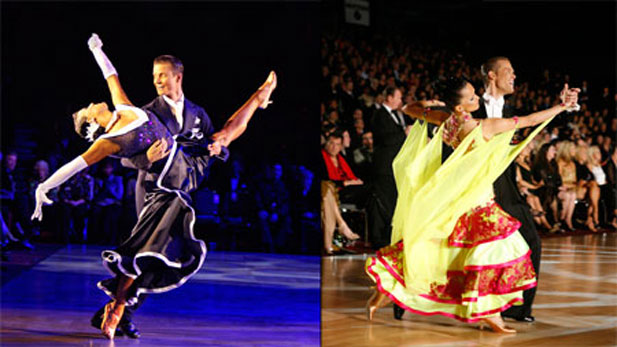
All four major dance styles are featured—American Smooth, American Rhythm, International Standard, and International Latin—with the focal point of the broadcast being the “show dances,” where each couple has the floor to themselves. An international panel of judges will decide which couple walks away with the crown.
Actress, singer, and dancer Jean Louisa Kelly joins the series as co-host this season. Ms. Kelly’s career has included leading roles on television, in feature films, and onstage. Seven-time U.S. National Latin Dance Champion Ron Montez returns to join Ms. Kelly as co-host of the series. America’s Ballroom Challenge executive producer Aida Moreno first brought competitive ballroom dancing to PBS with Championship Ballroom Dancing in 1980.
THE FOUR STYLE OF COMPETITIVE BALLROOM DANCE:
American Smooth
Think Fred and Ginger gliding across the screen, sometimes together, sometimes apart, but always in perfect time. This is American Smooth. Adapted in America from the traditional standard dances of Europe, American Smooth includes four dances that are also performed in the International Standard: Waltz, Tango, Foxtrot, and Viennese Waltz. But while the Standard dancers must remain in contact throughout, American Smooth couples are allowed to separate, and even perform solo moves, before joining up again. This “open hold” gives them more creative freedom and leads to a distinctly different kind of expression than is seen in the International Standard style.
American Rhythm
The dances in the American Rhythm division consist of the Cha Cha, Rumba, Swing, Bolero, and Mambo. They have wonderful hip and leg action, and are extremely sensual. With the exception of the Swing, which started in America, these sultry, sexy dances originated in Africa and Cuba. The essential ingredient of these dances is the suggestive hip rotation, referred to as “Cuban motion.” This is the only division where the Mambo,
Bolero and Swing are danced competitively.
International Standard
When one conjures an image of ballroom dancing, International Standard is the style that most often comes to mind: sweeping ballgowns, men in tails, and formal, regal dancing. With steps that date back hundreds of years to the royal courts of Europe, it is ballroom’s oldest style, its most recognizable—and, some would say, its most elegant. The competition includes five dances: Waltz, Tango, Viennese Waltz, Fox Trot, and
Quickstep. All five must be danced in the “closed position,” meaning that the man and woman must remain in contact at all times—in contrast to their American Smooth counterparts, who are allowed to separate and rejoin while performing many of the same steps.
Latin
Dancing doesn’t get any hotter than International Latin. Dazzling footwork, provocative moves and skimpy costumes define this sizzling style. The couples perform five dances – Cha Cha, Samba, Rumba, Paso Doble, and Jive—each one in its own way reflecting the timeless dance of seduction between a man and a woman. The fiercely competitive Latin couples attract the judges’ attention with flamboyant hair and makeup, dazzling
accessories … and costumes that leave just enough to the imagination.
For more information about the series and fun facts about ballroom dancing, visit pbs.org

By submitting your comments, you hereby give AZPM the right to post your comments and potentially use them in any other form of media operated by this institution.